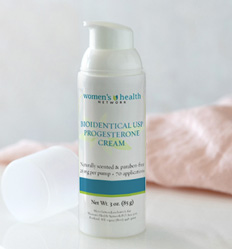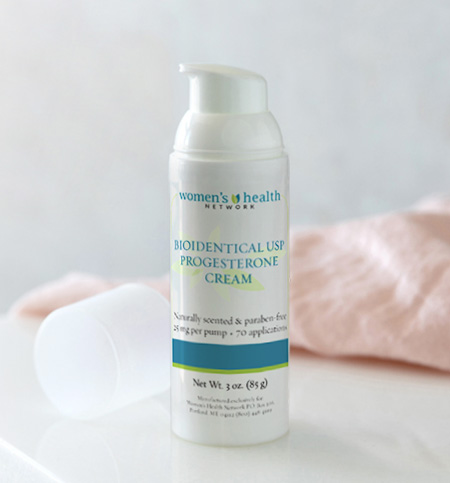Authored by Dr. Mary James, ND
During perimenopause, progesterone levels decline along with estrogen. But it’s not a gentle down glide with these hormones. Your progesterone levels may suddenly plummet, or your estrogen levels can remain high, and it’s this unbalanced ratio between estrogen and progesterone that causes a lot of trouble. A low progesterone-to-estrogen imbalance – known as estrogen dominance – can lead to symptoms ranging from weight gain to adult acne, plus many mood-related symptoms.
Is low progesterone causing these symptoms?
Estrogen often gets the starring role when we talk about menopause symptoms and other hormonal issues. But in reality, it’s often progesterone that’s driving the bus on why you’re experiencing symptoms. Is your progesterone ratio too low and in a state of imbalance? Common signs of low progesterone in perimenopause include:
1. Heavy or irregular periods
Progesterone is the main hormone responsible for regulating your cycle. Typical menstrual cycles are about 28 days long. If your cycle is much longer, much shorter or just unpredictable then this could be due to low progesterone.
2. Weight gain
If you are eating well and exercising, but have hormonal imbalance – including low progesterone – your body can go into weight gain mode no matter what you do.
3. Anxiety, depression, irritability and insomnia
Progesterone interacts with your neurotransmitters, particularly GABA. When progesterone is low you may have symptoms of depression, anxiety, irritability and insomnia which can get even worse before your cycle. Research shows that certain PMS symptoms – specifically mood-related ones like irritability, anxiety, fatigue, insomnia and even tearfulness — are tightly linked to low progesterone levels during that second half of the menstrual cycle, known as the luteal phase. One study notes that women with higher progesterone levels during this phase of their cycle have much less irritability and fatigue.
4. Adult acne
When your body’s progesterone and estrogen levels are thrown into imbalance, it can have a cascading effect on your other hormones, particularly an androgen called DHT (Dihydrotestosterone). DHT is thought to be a prime trigger for women’s adult acne. Studies have shown that progesterone helps to regulate the production of DHT and is a key to keeping it under control.
5. Low libido & sexual dysfunction
When progesterone falls out of ratio with estrogen in perimenopause, the imbalance can contribute to vaginal dryness, vaginal atrophy (a loss of muscle tension) and decreased clitoral sensitivity. It can be really difficult to get in the mood when these issues take hold.
6. Headaches
Women with low progesterone tend to get migraines, particularly before and during their cycle. This might be related to the increase in estrogen with low progesterone. Higher estrogen can cause vasodilation and water retention which can trigger headaches.
7. Sagging skin and wrinkles
Progesterone helps to stimulate production of collagen, which is essential for maintaining skin health. Without enough progesterone, skin can become saggy and wrinkled.
How stress “steals” your progesterone
Progesterone is one of several building blocks used by your body to make other hormones. A small amount of progesterone is made in the adrenal glands and is converted into cortisol, the body’s main stress hormone.
Chronic stress causes the body to use cortisol at a much faster rate. As a result, the cortisol pathway is prioritized and your body begins channeling pregnenolone — the precursor hormone to progesterone — for direct use in cortisol production. Less progesterone is available for other purposes, like your menstrual cycle – and symptoms can intensify. This is called the “pregnenolone steal.”
Can progesterone cream be used to relieve menopause symptoms?
So, now you’re probably wondering, is there anything you can do to boost your progesterone levels – or iron out that imbalanced progesterone-estrogen ratio? Diet may provide a little help because certain foods and nutrients may have an effect on progesterone levels in your body. Cruciferous vegetables (broccoli, kale, Brussels sprouts) contain a chemical called indole-3-carbinol that is thought to counter the effects of high-estrogen-to-progesterone. Vitamin B-6 (in foods like chickpeas, tuna, spinach and lean red meat) supports liver function which can help balance hormones, including progesterone and estrogen.
But there are other options that help restore balance and provide symptom relief. USP natural progesterone is considered bioidentical to women’s own naturally occurring hormones and can be a companion to other therapies or used alone.
For women who have tried other options that only provide partial relief — or none at all — bioidentical progesterone topical creams may help roll back some of the effects of hormonal imbalance. This is why non-prescription topical progesterone is so appealing. It is chemically similar to the progesterone in your body and has been proven safe.
Some research shows that this kind of progesterone can also decrease levels of the stress hormone cortisol over time. High cortisol is responsible for, or complicit in, the formation of many other symptoms and health threats. Even for hot flashes, which are notoriously persistent menopause symptoms, topical progesterone has shown to be effective for many women.
Will topical progesterone work for you?
Severe menopause symptoms can crush the joy out of everyday life and magnify your fears about how your body is changing. But it doesn’t have to be this way, and you don’t have to resort to extreme measures.
Even with dramatic hormone fluctuations in perimenopause, your body has the ability to adapt to the changes. Many women get good results with topical progesterone over time without having to worry about side effects. The best topical progesterone remedies have special application instructions that mimic the way progesterone rises and falls during the average menstrual cycle.
We each have a different hormonal profile which means our symptom experience is unique too. As with many natural remedies, the best way to know if topical progesterone will ease your specific menopause symptoms is to try it for several months to measure its effectiveness.











